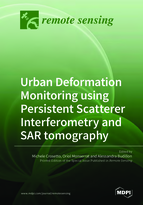Urban Deformation Monitoring using Persistent Scatterer Interferometry and SAR tomography
A special issue of Remote Sensing (ISSN 2072-4292). This special issue belongs to the section "Remote Sensing in Geology, Geomorphology and Hydrology".
Deadline for manuscript submissions: closed (30 November 2018) | Viewed by 102170
Special Issue Editors
Interests: radar interferometry; persistent scatterer interferometry; ground-based SAR; deformation monitoring; real-aperture-radar; vibration monitoring
Interests: remote sensing data processing; SAR data; SAR interferometry; geohazards monitoring; landslide mapping; building monitoring; land subsidence
Special Issues, Collections and Topics in MDPI journals
Special Issue Information
Dear Colleagues,
Our capability to monitor deformation using satellite-based SAR sensors has increased substantially in the last years, thanks to the availability of multiple SAR sensors and the development of several data processing and analysis procedures. This Special Issue is focused on the deformation monitoring in urban areas based on two techniques: Persistent Scatterer Interferometry (PSI) and SAR tomography (TomoSAR). The Special Issue targets collecting the latest innovative research results related to at least one of the abovementioned techniques. These can include new data processing algorithms and procedures, results based on new types of SAR data, and the development of innovative urban deformation monitoring applications. The topics of interest include, but are not limited to:
· New PSI algorithms for urban deformation monitoring,
· PSI results based on new types of data, included polarimetric SAR data,
· Persistent Scatterers and Distributed Scatterers in urban deformation monitoring,
· Integration and fusion with data from multiple sources,
· Development of innovative urban deformation monitoring PSI applications,
· New TomoSAR algorithms for urban deformation monitoring,
· TomoSAR results based on new types of data, including polarimetric SAR data,
· Development of innovative urban deformation monitoring TomoSAR applications,
· PSI and TomoSAR cross-comparison,
· PSI and TomoSAR validation,
· Assessment of PSI and TomoSAR performances for urban deformation monitoring, and
· Review papers on PSI and TomoSAR for urban deformation monitoring.
Dr. Michele Crosetto
Dr. Oriol Monserrat
Dr. Alessandra Budillon
Guest Editors
Manuscript Submission Information
Manuscripts should be submitted online at www.mdpi.com by registering and logging in to this website. Once you are registered, click here to go to the submission form. Manuscripts can be submitted until the deadline. All submissions that pass pre-check are peer-reviewed. Accepted papers will be published continuously in the journal (as soon as accepted) and will be listed together on the special issue website. Research articles, review articles as well as short communications are invited. For planned papers, a title and short abstract (about 100 words) can be sent to the Editorial Office for announcement on this website.
Submitted manuscripts should not have been published previously, nor be under consideration for publication elsewhere (except conference proceedings papers). All manuscripts are thoroughly refereed through a single-blind peer-review process. A guide for authors and other relevant information for submission of manuscripts is available on the Instructions for Authors page. Remote Sensing is an international peer-reviewed open access semimonthly journal published by MDPI.
Please visit the Instructions for Authors page before submitting a manuscript. The Article Processing Charge (APC) for publication in this open access journal is 2700 CHF (Swiss Francs). Submitted papers should be well formatted and use good English. Authors may use MDPI's English editing service prior to publication or during author revisions.
Keywords
- Satellite-based Synthetic Aperture Radar,
- Differential Interferometric SAR,
- Persistent Scatterer Interferometry,
- SAR tomography,
- Deformation monitoring,
- Urban deformation monitoring,
- Monitoring applications,
- Cross-comparison,
- Validation.





